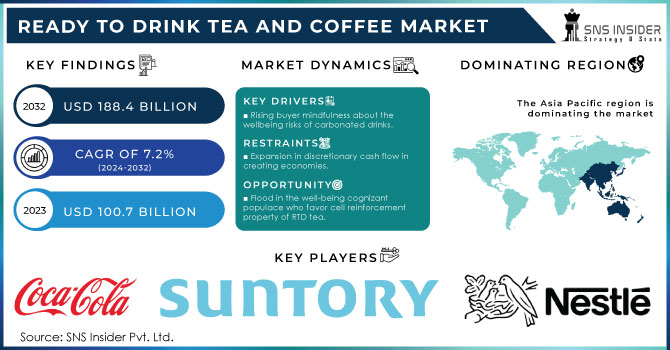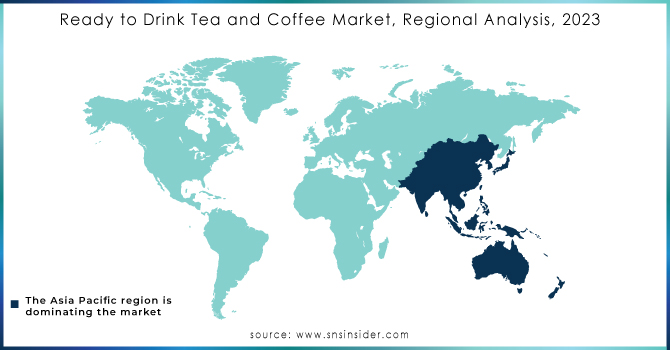Ready to Drink Tea and Coffee Market Size Analysis:
The Ready to Drink Tea and Coffee Market size was valued at USD 100.7 billion in 2023 and is expected to reach USD 188.4 billion by 2032 and grow at a CAGR of 7.2% over the forecast period 2024-2032.

Get More Information on Ready to Drink Tea and Coffee Market - Request Sample Report
The Ready to Drink tea and Ready to Drink espresso is the sub gathering of sodas, yet varies in the capacity with demonstrated medical advantages. The market for Ready to Drink tea and Ready to Drink espresso is developing dramatically. Different kinds of RTD tea and RTD espresso items are acquainted in the market with serving the wide purchaser base spread across topographies. For additional extension, youthful grown-ups and wellbeing cognizant customers are designated. Different nutraceutical fixings are being consolidated to make them more utilitarian. Asia-Pacific is the most overwhelming business sector through North America is the quickest developing Ready to Drink tea and Ready to Drink espresso market.
Rising customer mindfulness about the wellbeing perils of carbonated drinks is prompting a shift towards Ready to Drink tea and Ready to Drink espresso. Another significant driver is flood in the wellbeing cognizant populace who lean toward cell reinforcement property of RTD tea. Tweaking wellbeing useful items for ladies and kids are the methodologies of the central parts to extend on the lookout. Situating of the RTD tea and Ready to Drink espresso market as sporting items has demonstrated helpful in drawing in more youthful populace. Expansion in extra cash in creating economies is another element setting off the development pace of RTD tea and Ready to Drink espresso market.
Eccentric precipitation and expansion in cost of farming data sources had prompted an expansion in cost of unrefined components; tea and espresso which makes the eventual outcome exorbitant. Greater expense than hot tea and ground espresso is a significant restriction of the market. Age-old customary acts of drinking hot tea and espresso are making deterrents to the development of the market. The triumphant basic of the business is conveyance union executed by the key part which helps in providing the item to distant geologies and expanding the permeability of the item.
Market Dynamics:
Driving Factors:
-
Rising buyer mindfulness about the wellbeing risks of carbonated drinks.
Restraining Factors:
-
Expansion in discretionary cash flow in creating economies.
-
Capricious precipitation and expansion in the cost of horticultural data sources had prompted an expansion in the cost of unrefined components.
Opportunities:
-
Flood in the well-being cognizant populace who favor cell reinforcement property of RTD tea.
Challenges:
-
Age-old conventional acts of drinking hot tea and espresso.
Impact of Covid-19:
The COVID-19 episode has decidedly affected the development of the general food and drink industry, including items like RTD tea and espresso. The pandemic has upgraded tea utilization. The emotional increment was driven by wellbeing and health, yet in addition by the capacity of tea to give a sensation of solace. RTD tea and espresso are a subgroup of sodas however contrast in work with demonstrated medical advantages.
Product type:
The RTD tea section drove the market. A portion of the regularly consumed RTD tea variations is a dark, green, natural product, homegrown, matcha, oolong, and chilled. Inferable from the rising working populace and feverish timetables of experts, item request has heightened fundamentally. The developing inclination for carbonated RTD tea among shoppers is driving the section development. The RTD espresso portion is expected to extend at the quickest CAGR. Not many of the generally found RTD espresso variations in the market are yerba mate, guarana, acai berry, ginseng, taurine, and chilled. Espresso is a very much acknowledged refreshment and is viewed as a sound swap for carbonated sodas, subsequently, the interest in the item is probably going to dramatically develop.
Packaging:
PET containers offer more prominent breakage opposition and consume lesser energy and time during assembling than glass bottles. The interest in PET containers for bundling RTD tea and espresso is ascending because of their recyclability and reusability. PET jugs are effortlessly reused from many sorts of auxiliary items, including cushion stuffing, cover strands, handbags, and lashing materials. Canned bundling was the second-biggest section and is projected to develop considerably over the gauge period. The development of the fragment is credited to its advantages like flavor protection and improved item timeframe of realistic usability. The canned bundling of these drinks adds to the comfort of purchasers.
Distribution Channel:
General stores/hypermarkets made the biggest commitment to the worldwide market concerning income. Changing retail scene and the developing number of general store chains, particularly in thickly populated nations like India, are powering the deals of RTD tea and espresso through this channel. The movement of the foodservice business as a dispersion channel has drawn the consideration of an enormous number of makers. The food service dissemination channel comprises of an organization of merchants that supply items to cafeterias, lodgings and eateries, and modern caterers, among others. General stores are flourishing all over the planet attributable to rising urbanization and simple openness requested by purchasers. In most creating economies, general stores are commonly situated inside a private municipality or close to workplaces, making them helpful for occupied clients to make speedy buys.
Key Market Segmentation:
By additives:
-
Flavors
-
Artificial sweeteners
-
Acidulants
-
Nutraceuticals
-
Preservatives
-
Others
By types:
-
Ready to drink tea
-
Ready to drink coffee
By packaging:
-
Glass bottle
-
Canned
-
Pet bottle
-
Fountain/Aseptic
-
Others
By price segment:
-
Premium
-
Regular
-
Popular priced
-
Fountain
-
Super premium
By distribution channel:
-
Off-trade
-
Independent retailers
-
Supermarkets/Hypermarkets
-
Convenience stores
-
Others
-
-
On-trade
-
Food service
-
-
Vending
Regional Analysis:
-
North America
-
The USA
-
Canada
-
Mexico
-
-
Europe
-
Germany
-
The UK
-
France
-
Italy
-
Spain
-
The Netherlands
-
Rest of Europe
-
-
Asia-Pacific
-
Japan
-
south Korea
-
China
-
India
-
Australia
-
Rest of Asia-Pacific
-
-
The Middle East & Africa
-
Israel
-
UAE
-
South Africa
-
Rest of Middle East & Africa
-
-
Latin America
-
Brazil
-
Argentina
-
Rest of Latin America
-
The Asia Pacific made the biggest commitment to the worldwide market. Nations like India, China, and Japan, which have countless tea and espresso estates, drive the interest for these items in the district. The market in the Asia Pacific is expected to observe sound development throughout the next few years, especially in Indonesia and Thailand. The Middle East and Africa market is supposed to grow at the most noteworthy CAGR. Changing retail scene combined with maximum usage of these items is supposed to give a lift to the market in the locale. North America is supposed to observe moderate development, significantly determined by the U.S. furthermore, Canada. The development of RTD tea and espresso is upheld by the rising significance given to wellbeing and worked on dietary propensities.

Need any customization research on Ready to Drink Tea and Coffee Market- Enquiry Now
Key Players:
Suntory Holdings Limited, Nestlé, The Coca-Cola Company, Unilever, Asahi Group Holdings, Ltd., PepsiCo, Starbucks Coffee Company, Monster Energy Company, Danone, AriZona Beverages USA.
| Report Attributes | Details |
|---|---|
| Market Size in 2023 | USD 100.7 Billion |
| Market Size by 2032 | USD 188.4 Billion |
| CAGR | CAGR 7.2% From 2024 to 2032 |
| Base Year | 2022 |
| Forecast Period | 2024-2032 |
| Historical Data | 2020-2022 |
| Report Scope & Coverage | Market Size, Segments Analysis, Competitive Landscape, Regional Analysis, DROC & SWOT Analysis, Forecast Outlook |
| Key Segments | • by Additives (Flavors, Artificial sweeteners, Acidulants, Nutraceuticals, Preservatives, Others) • by Types (Ready to drink tea, Ready to drink coffee) • by Packaging (Glass bottle, Canned, Pet bottle, Fountain/Aseptic, Others) • by Price segment (Premium, Regular, Popular priced, Fountain, Super premium) • by Distribution channel (Off-trade, On-trade) |
| Regional Analysis/Coverage | North America (USA, Canada, Mexico), Europe (Germany, UK, France, Italy, Spain, Netherlands, Rest of Europe), Asia-Pacific (Japan, South Korea, China, India, Australia, Rest of Asia-Pacific), The Middle East & Africa (Israel, +D11UAE, South Africa, Rest of Middle East & Africa), Latin America (Brazil, Argentina, Rest of Latin America) |
| Company Profiles | Suntory Holdings Limited, Nestlé, The Coca-Cola Company, Unilever, Asahi Group Holdings, Ltd., PepsiCo, Starbucks Coffee Company, Monster Energy Company, Danone, AriZona Beverages USA. |
| Key Drivers | •Rising buyer mindfulness about the wellbeing risks of carbonated drinks. |
| Market Opportunities | •Flood in the well-being cognizant populace who favor cell reinforcement property of RTD tea. |

